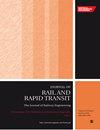Study on the optimization of high-speed turnout crossing structures based on actual elastic deformation of point and splice rails
IF 1.7
4区 工程技术
Q3 ENGINEERING, CIVIL
Proceedings of the Institution of Mechanical Engineers Part F-Journal of Rail and Rapid Transit
Pub Date : 2023-07-03
DOI:10.1177/09544097231175531
引用次数: 0
Abstract
In this paper, to address the shortcomings of the crossing structure design based on the elastic bending center method and the lack of related research, an optimization method for high-speed turnout crossing structures was proposed based on the actual elastic deformations of point and splice rails. Based on the finite element theory, the actual loading characteristics and spatial variable section characteristics of point and splice rails were fully considered, and a refined simulation analysis model of the switching system of point and splice rails in crossing areas was established. Moreover, the elastic deformation lines of point and splice rails in the nonworking state were obtained for the first time, which were consistent with actual situations. On this basis, system optimization was performed for the connecting parts of the crossing with a movable point in a high-speed turnout. In the crossing structure simulation model, the length adjustment values of the first–sixth spacer blocks between the branch line–wing and point rails and between the mail line–wing splice rails were ≤1 mm. Moreover, the lengths of the seventh–ninth spacer blocks decreased by gradually increasing amounts, and the length of the ninth spacer block decreased the most (∼6 mm). The length of the second spacer block between the point and splice rails slightly increased, but the length of the third spacer block significantly decreased by 6 mm. The length adjustment value of the distance block between the point and splice rails was smallest (0.7 mm). The calculated optimal lengths of the connecting parts of the crossing were found to be close to the empirical values used in actual manufacturing processes, and the dimension optimization patterns were completely consistent with actual situation, which validates the proposed optimization method. Thus, the proposed method can effectively improve the coordination between rails and connecting parts in crossing areas, substantially reduce internal stresses in crossing systems, and improve their assembly performance and service life. Moreover, the proposed optimization parameters can provide valuable references for the research on next-generation high-speed turnouts (400 km/h) and for improving the designs of existing high-speed turnouts.基于点接轨实际弹性变形的高速道岔道岔结构优化研究
针对基于弹性弯曲中心法的道岔结构设计存在的不足和相关研究的不足,提出了一种基于点、接轨实际弹性变形的高速道岔道岔结构优化方法。基于有限元理论,充分考虑点接轨的实际载荷特性和空间变截面特性,建立了交叉口点接轨切换系统的精细化仿真分析模型。首次得到了点轨和拼接轨在非工作状态下的弹性变形线,与实际情况吻合。在此基础上,对高速道岔中带活动点的道岔连接部分进行了系统优化。在交叉结构仿真模型中,支路-翼与点轨之间、干线-翼拼接轨之间的第1 - 6个间隔块的长度调整值≤1 mm。此外,第7 ~ 9个间隔块的长度逐渐减少,其中第9个间隔块的长度减少最多(约6 mm)。点与接轨之间的第二个间隔块长度略有增加,而第三个间隔块的长度则显著减少了6 mm。点与接轨之间距离块的长度调节值最小(0.7 mm)。计算出的十字路口连接件最优长度与实际制造过程中的经验值接近,尺寸优化模式与实际情况完全吻合,验证了所提出的优化方法的有效性。因此,该方法可有效改善跨区轨道与连接件之间的协调性,大幅降低跨区系统的内应力,提高跨区系统的装配性能和使用寿命。此外,所提出的优化参数可为下一代高速道岔(400km /h)的研究和现有高速道岔的改进设计提供有价值的参考。
本文章由计算机程序翻译,如有差异,请以英文原文为准。
求助全文
约1分钟内获得全文
求助全文
来源期刊

CiteScore
4.80
自引率
10.00%
发文量
91
审稿时长
7 months
期刊介绍:
The Journal of Rail and Rapid Transit is devoted to engineering in its widest interpretation applicable to rail and rapid transit. The Journal aims to promote sharing of technical knowledge, ideas and experience between engineers and researchers working in the railway field.
 求助内容:
求助内容: 应助结果提醒方式:
应助结果提醒方式:


